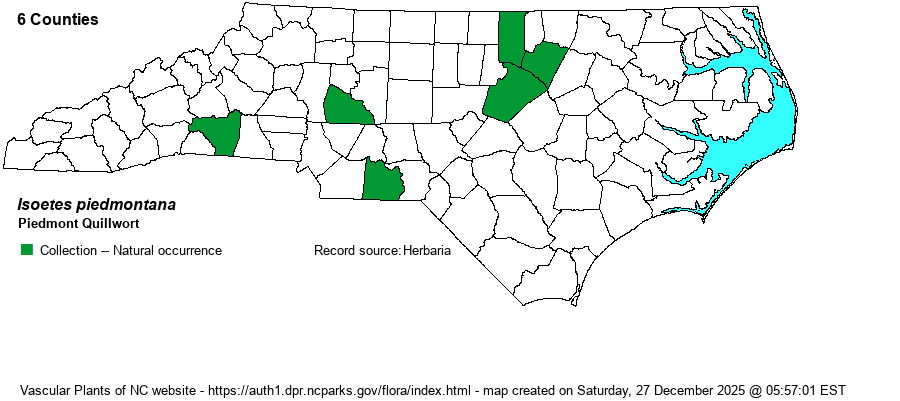| Section 1 » Order Isoetales » Family Isoetaceae |
Show/Hide Synonym
| taxonName | relationship | relatedTaxonName | relatedTaxonRefText | relComments |
|---|
|
|
|
| Isoetes piedmontana | < | Isoetes melanopoda | Radford, Ahles, and Bell (1968) | | | Isoetes piedmontana | < | Isoetes virginica | Gleason and Cronquist (1991) | | | Isoetes piedmontana | < | Isoetes virginica | Fernald (1950) | | | Isoetes piedmontana | < | Isoetes virginica | Flora of North America (1993b, 1997, 2000, 2002a, 2002b, 2003a, 2004b, 2005, 2006a, 2006b, 2006c, 2007a, 2009, 2010) | | | Isoetes piedmontana | < | Isoetes virginica | Gleason (1952) | | | Source: Weakley's Flora |
|
| Author | (Pfeiffer) Reed | |
| Distribution | Found only at scattered locations in the Piedmont, primarily in the northeastern counties, and restricted to areas where there are granitic flatrocks.
This is a mainly Piedmont species, found from southern VA (one site) to eastern AL.
| |
| Abundance | Very rare as a whole across the Piedmont, limited to tiny spots on the ground (granitic flatrocks). It is locally fairly common in the Wake-Franklin County area, but uncommon at other sites. The NCNHP database lists 16 records, about 13 still extant. This is a State Threatened species (as of May 2021); it formerly had been listed as State Endangered. | |
| Habitat | This species is restricted to flatrocks, where there is some seepage, as this and all other Isoetes species grow in wetlands or wet places. One site is a diabase flatrock, but all others are at granitic flatrocks. |
| Phenology | Fruits from May to October. | |
| Identification | All Isoetes species are quite grass-like, with numerous very slender and grass-like leaves growing from a common base. Most importantly, they are swollen at the base, where the megaspores are present, the key structure for separation of species. The leaves are terete (rounded) and hollow. For identification, see the key in Weakley (2018). | |
| Taxonomic Comments | Former references, such as RAB (1968), included this species within I. melanopoda.
All Isoetes species are quite grass-like, with numerous very slender and grass-like leaves growing from a common base. Most importantly, they are swollen at the base, where the megaspores are present, the key structure for separation of species. The leaves are terete (rounded) and hollow. For identification, see the key in Weakley (2018). | |
| Other Common Name(s) | Black-based Quillwort | |
| State Rank | S2 | |
| Global Rank | G4 | |
| State Status | T | |
| US Status | | |
| USACE-agcp | OBL link |
| USACE-emp | OBL link |

